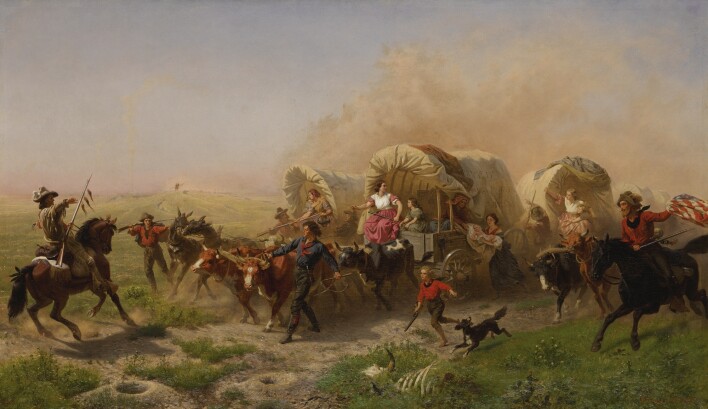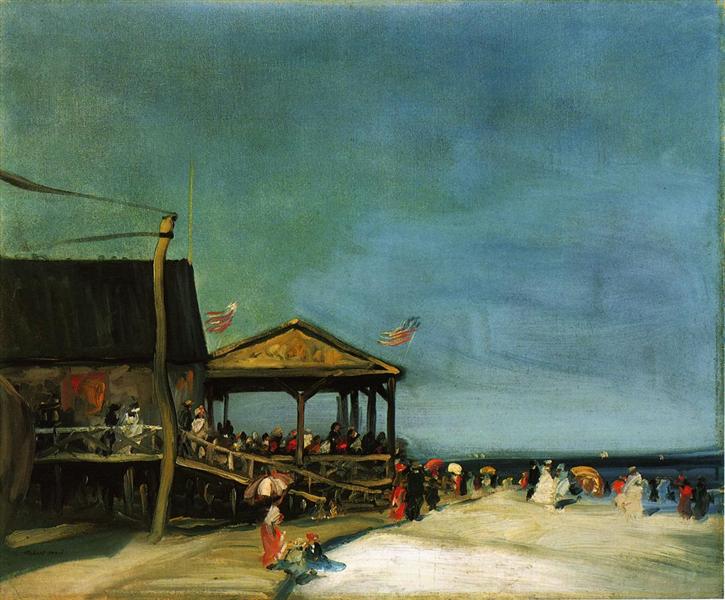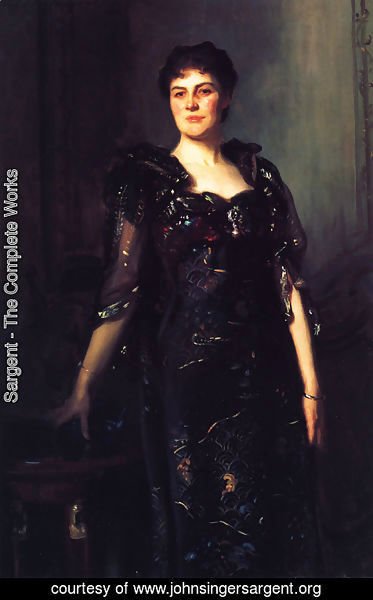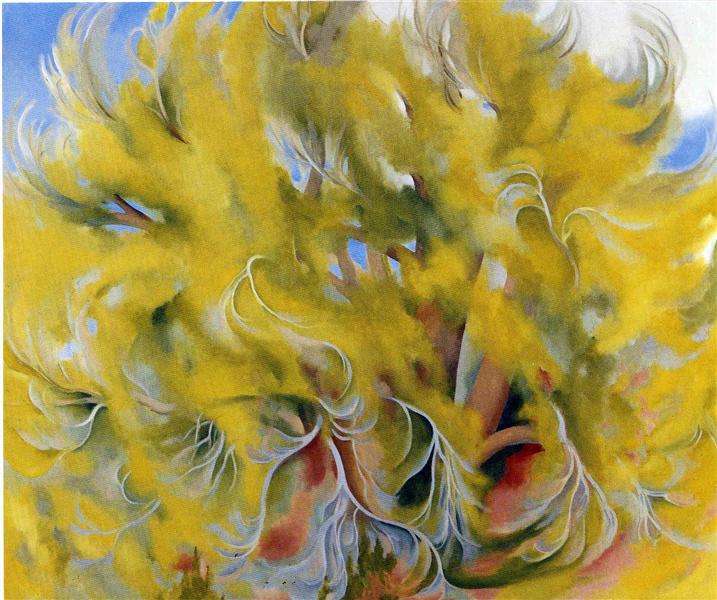
Sotheby’s has announced that Edward Hopper’s Two Comedians will lead the American Art Auction in New York on 16 November 2018 (estimate $12/18 million). Painted in 1966, Two Comedians ranks among the most poignant and personal works in Hopper’s celebrated oeuvre. Evocative of many of the most important themes in Hopper’s body of 2work, this seminal painting is distinguished further by its notable provenance: it was acquired by Frank and Barbara Sinatra in 1972, and remained in their collection until it was purchased by the current owner in 1995.
The present work represents the culmination of Hopper’s career, presenting a self-portrait of the artist and his wife, Jo, on stage, taking a final bow before turning to walk into the unknown.Jo served as Hopper’s primary model and muse throughout his oeuvre, yet she was typically portrayed as an anonymous character in an enigmatic scene. In Two Comedians,Hopper depicts his wife explicitly as the two figures hold hands and gesture tenderly toward one another, a positioning that symbolizes their close bond and the significant role Jo played in the artist’s life and art.
Two Comedians manifests a number of leitmotifs that recur throughout Hopper’s career. His choice of a stage for the setting of the present work speaks to his lifelong interest in theate rand film, as well as his voyeuristic approach to his art and his interest in watching his subjects interact with their environments. Hopper also depicts himself and Jo as17thcentury Italian performers, known as Pierrots. He crops the work to eliminate the audience, a decision that speaks to his affinity for performers and his consideration of them as fellow outsiders, who shared the same sense of detachment he often felt during his life. The empty spaces and voids found throughout Hopper’s work are connected to the theme of death, which is emotionally manifested in the darkly nebulous background of Two Comedians. #
GRANT WOOD’S SEMINAL PORTRAIT OF HIS SISTER, NAN
On offer for the first time in over 65 years, Portrait of Nan comes to auction at a time of heightened interest in Grant Wood’s work, following his recent 2018 retrospective at the Whitney Museum of American Art (estimate $1.5/2.5 million). This extremely personal work portrays Wood's beloved sister Nan, whose likeness is most recognized in the artist's American Gothic from 1931, one of the most iconic images in 20th century art. In response to the criticism the artist received for his stern depiction of Nan in American Gothic, Wood painted Portrait of Nan one year later as a heartfelt apology to his sister.
The only work Wood refused to sell in his lifetime, Portrait of Nan remained in the artist's collection until his death in 1942. In 1952, the work was purchased by Senator William Benton of Connecticut, the publisher of the Encyclopedia Britannica, and an important patron of American modernism, and subsequently descended to his daughter Helen Boley, appearing at auction this November from her estate.
A NORMAN ROCKWELL CHRISTMAS
Leading the selection of five works on offer by Norman Rockwell is his Tired Salesgirl on Christmas Eve (estimate $5/7 million), which served as the cover illustration for the 27 December 1947 edition of The Saturday Evening Post, and which has remained in the same private collection since it was last sold in 1996. The painting depicts a department store employee on Christmas Eve after a strenuous shift, exhausted by the relentless onslaught of customers seeking last-minute gifts. To create this composition, Rockwell had elements of the scene photographed on-site at the Marshall Field department store in Chicago, and asked a 17-year-old waitress he discovered working at a diner nearby to pose as his protagonist. The work demonstrates Rockwell’s undeniable gift for visual narration, and captures an aspect of the holiday season that would become increasingly common throughout the century.
A RARE & MONUMENTAL CANVAS BY EMANUEL GOTTLIEB LEUTZE

The selection of Western art on offer this November is led by Emanual Gottlieb Leutze's Western Emigrant Train Bound for California Across the Plains, Alarmed by Approach of Hostile Indians (estimate $2.5/3.5 million). Though Leutze was born in Germany in 1816 and spent most of his life living and working there, his paintings of the significant figures and historical events of 18th and 19th century America rank as the most celebrated images of his oeuvre - including his iconic image of Washington Crossing the Delaware (The Metropolitan Museum of Art, New York). Painted in 1863, this dynamic image represents one of Leutze’s finest achievements on the subject of Manifest Destiny and the struggle to tame the Wild West. Highly ambitious and sophisticated in both content and form, the painting exemplifies the unique synthesis of realism and idealism that allowed Leutze to successfully mythologize episodes of American history.
Measuring more than 5.5 feet across, the impressively-scaled work is being sold this fall to benefit the Dover Free Public Library in Dover, New Jersey, where it has resided since it was gifted to the institution in 1943.
HORACE PIPPIN’S AUTOBIOGRAPHICAL WORK
A self-taught painter from West Chester, Pennsylvania, Horace Pippin began producing art at age 37, after his honorable discharge from the United States army due to an injury.

The pastoral Holy Mountain, I presents an autobiographical scene, with a harmonic foreground that is contrasted by the soldiers marching through the ominous forested background (estimate $1/1.5 million). The painting is first in a series of four works Pippin executed on this subject. Reflecting both his personal experiences in World War II and the cultural climate of the period, the painting – dated June 6, 1994 – corresponds with D-Day, further reinforcing the ideological dichotomy between war and peace. Holy Mountain, I last appeared at auction in 1981 at Sotheby’s New York, establishing the artist’s auction record of $385,000 that has held to this day.
THE ESTATE OF ESTELLE WOLF
Sotheby’s will present a group of four works from the Estate of Estelle Wolf are led by

Robert Henri’s At Far Rockaway from 1902, an important 20th century landscape of Rockaway Beach in New York City that represents a pivotal moment in the artist’s career (estimate $700,000/1,000,000). At Far Rockaway represents one of the earliest examples of Henri's works that demonstrate the influence of the Spanish tradition of painting, which turned the attention of a generation of important American artists including George Bellows and Edward Hopper toward the gestural European style.

John Singer Sargent’s portrait Mrs. Charles Anstruther-Thomson is another highlight from the Wolf Estate (estimate $450/550,000). The work depicts Anges Anstruther-Thomson, a fashionable member of London society and wife of prominent Scottish landowner Charles Anstruth-Thomson. The painting remained with Mrs. Charles Anstruther-Thomson and descended in her family until it was sold at Sotheby's in 1981.
GEORGIA O’KEEFFE’S SOUTHWESTERN INSPIRATION
Four years following the sale of

Georgia O’Keeffe’s iconic flower painting Jimson Weed/White Flower No. 1, Sotheby’s announced that they will again offer three important works by the artist from the Georgia O’Keeffe Museum in Santa Fe, New Mexico to benefit its Acquisitions Fund.
The American Art auction on 16 November is highlighted by

Cottonwood Tree in Spring from 1943 (estimate $1.5/2.5 million).
O’Keeffe started to visit New Mexico regularly in 1929 when, in an effort to escape city life, she left New York to spend the summer there.
Works such as Cottonwood Tree in Spring reveal the profound inspiration O’Keeffe gleaned from the American Southwest. The sublime beauty of the landscape provided a free range for her imagination, and she would continue to investigate its imagery for the remainder of her life, returning almost every summer until 1949 when she made Abiquiu her permanent home. While the artist had always utilized the natural world as the basis for her unique visual language, in New Mexico her art gained an even deeper intimacy and, in works such as Cottonwood Tree in Spring, it transcends a literal study of nature to evoke the spiritual connection she felt with her adopted home.
Two additional works by the artist from the O’Keefe Museum –

A Street, a rare and highly significant depiction of New York City from 1926, and the striking

Calla Lilies on Red from 1928 – will highlight the Contemporary Art Evening Auction on 14 November 2018.
/https://public-media.smithsonianmag.com/filer/99/ce/99ce3dad-1ca8-4cd1-a0cc-60d7301c6424/may14_g06_mall.jpg)